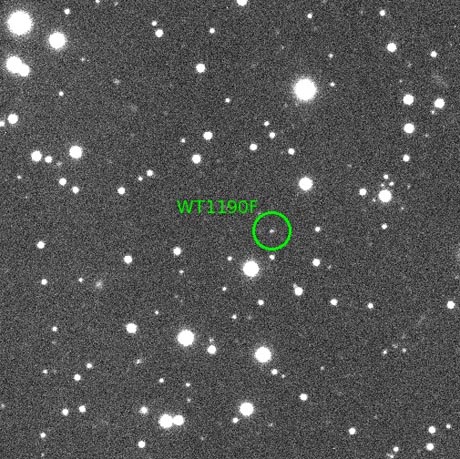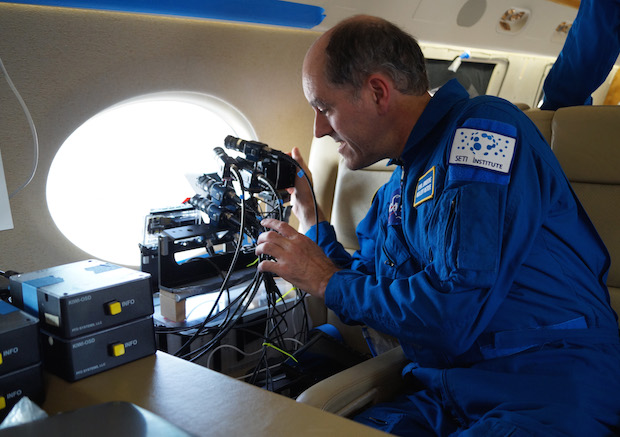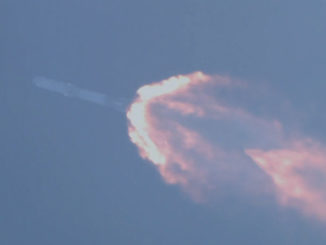
A long-lost fragment of space debris is falling toward Earth for a searing re-entry over the Indian Ocean on Friday, but the widely-watched event poses no risk to people.
Nevertheless, aviation and maritime authorities have cautioned pilots and sailors to steer clear of the expected re-entry zone just south of Sri Lanka.
Re-entry is expected at 0618:34.3 GMT (1:18:34.3 a.m. EST), plus or minus 1.3 seconds. That is the time the object is forecast to be 100 kilometers, or about 60 miles, above Earth’s surface, the internationally-recognized boundary of space.
Astronomers with the University of Arizona’s Catalina Sky Survey spotted the mysterious object, known as WT1190F, while scanning the sky for near-Earth asteroids. Scientists had already tracked WT1190F twice in 2013, and a computation of the object’s trajectory last month showed it was on a collision course with Earth.
Experts estimated the object’s density by calculating how much solar radiation pressure — a tiny but constant force — changed its path over the last two years.
“It turns out that this body has a mean density that is about 10 percent that of water,” scientists with the European Space Agency wrote in a summary of their findings last month. “This is too low to be a natural space rock, but it is compatible with being a hollow shell, such as the spent upper stage of a rocket.”
The origin of WT1190F is unknown, but it could come from a rocket stage used on one of China’s recent robotic missions, or it could date back to the human voyages to the moon of the Apollo era. The object, about 1 to 2 meters (3 to 6 feet) across, was left in a highly elliptical orbit around Earth taking it twice as far as the moon during each circuit of the planet.
An airborne team of researchers plans to fly near the projected impact site aboard a Gulfstream 450 jet in a bid to observe the entry, which will occur in daylight over the Indian Ocean. For the airborne research team, and observers on the ground if the weather is clear, scientists expect the falling object to produce a bright fireball that should be visible even in daytime.
Chartered by the International Astronomical Center and the United Arab Emirates Space Agency, the Gulfstream 450 flight hosts scientists from the IAC, the UAE Space Agency, NASA’s Ames Research Center, the SETI Institute, the Clay Center Observatory in Massachusetts, Embry-Riddle Aeronautical University, and two researchers from the University of Stuttgart in Germany sponsored by the European Space Agency.
“What makes the return of this man-made object so special is that it moves on a very elongated orbit, returning to Earth only once every 23 days,” said Mohammed Odeh, director of the IAC, a scientific center based in Abu Dhabi. “When WT1190F, as it is called, finally hits the Earth’s atmosphere, it comes in steeper and faster than normal.”
ESA predicts the piece of space debris to plummet to Earth at 11 kilometers per second, or nearly 25,000 mph. That is faster than any fragment of falling space junk in low Earth orbit, but not as quick as many asteroids and small meteors streaking into the atmosphere.
Little of the object, and perhaps none, will survive the scorching re-entry. Anything that does stay intact will fall in the Indian Ocean about 100 kilometers, or 60 miles, south of Sri Lanka.

Peter Jenniskens, a meteor expert from the SETI Institute and NASA Ames, says the opportunity to study the re-entry of WT1190F will offer insights into how natural objects burn up and disintegrate in the atmosphere.
“The manner in which asteroids break up during entry is key to understanding what happens if another asteroid hits like the one that shattered near the Russian city of Chelyabinsk in February of 2013”, Jenniskens said in a press release from the International Astronomical Center. “The shock wave of that detonation smashed windows and send over 1,600 people to the hospital for treatment of injuries from flying glass.”
Scientists say the example of WT1190F, which was discovered to be heading toward Earth a month in advance, is a model for potential asteroid impacts in the future, where incoming objects could be found with weeks of warning.
“First, the object is interesting to better understand the re-entry of satellites and debris from high orbits,” ESA officials wrote in an announcement of the re-entry last month. “Second, it provides us with an ideal opportunity to test our readiness for any possible future events involving an asteroid, since the components of this scenario, from discovery to impact, are all very similar.”
Email the author.
Follow Stephen Clark on Twitter: @StephenClark1.



